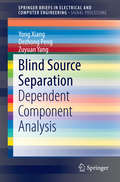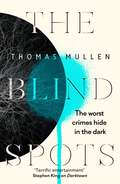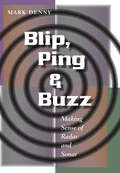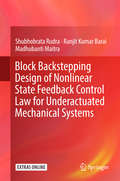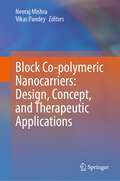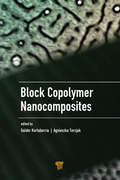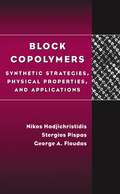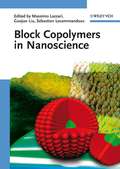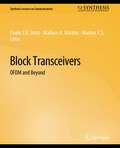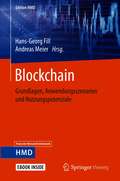- Table View
- List View
Blind Signal Processing: Theory and Practice
by Xizhi Shi"Blind Signal Processing: Theory and Practice" not only introduces related fundamental mathematics, but also reflects the numerous advances in the field, such as probability density estimation-based processing algorithms, underdetermined models, complex value methods, uncertainty of order in the separation of convolutive mixtures in frequency domains, and feature extraction using Independent Component Analysis (ICA). At the end of the book, results from a study conducted at Shanghai Jiao Tong University in the areas of speech signal processing, underwater signals, image feature extraction, data compression, and the like are discussed. This book will be of particular interest to advanced undergraduate students, graduate students, university instructors and research scientists in related disciplines. Xizhi Shi is a Professor at Shanghai Jiao Tong University.
Blind Source Separation: Advances in Theory, Algorithms and Applications (Signals and Communication Technology)
by Ganesh R. Naik Wenwu WangBlind Source Separation intends to report the new results of the efforts on the study of Blind Source Separation (BSS). The book collects novel research ideas and some training in BSS, independent component analysis (ICA), artificial intelligence and signal processing applications. Furthermore, the research results previously scattered in many journals and conferences worldwide are methodically edited and presented in a unified form. The book is likely to be of interest to university researchers, R&D engineers and graduate students in computer science and electronics who wish to learn the core principles, methods, algorithms and applications of BSS. Dr. Ganesh R. Naik works at University of Technology, Sydney, Australia; Dr. Wenwu Wang works at University of Surrey, UK.
Blind Source Separation: Dependent Component Analysis (SpringerBriefs in Electrical and Computer Engineering)
by Yong Xiang Dezhong Peng Zuyuan YangThis book provides readers a complete and self-contained set of knowledge about dependent source separation, including the latest development in this field. The book gives an overview on blind source separation where three promising blind separation techniques that can tackle mutually correlated sources are presented. The book further focuses on the non-negativity based methods, the time-frequency analysis based methods, and the pre-coding based methods, respectively.
Blind Source Separation: Theory and Applications
by Xianchuan Yu Dan Hu Jindong XuA systematic exploration of both classic and contemporary algorithms in blind source separation with practical case studies The book presents an overview of Blind Source Separation, a relatively new signal processing method. Due to the multidisciplinary nature of the subject, the book has been written so as to appeal to an audience from very different backgrounds. Basic mathematical skills (e.g. on matrix algebra and foundations of probability theory) are essential in order to understand the algorithms, although the book is written in an introductory, accessible style. This book offers a general overview of the basics of Blind Source Separation, important solutions and algorithms, and in-depth coverage of applications in image feature extraction, remote sensing image fusion, mixed-pixel decomposition of SAR images, image object recognition fMRI medical image processing, geochemical and geophysical data mining, mineral resources prediction and geoanomalies information recognition. Firstly, the background and theory basics of blind source separation are introduced, which provides the foundation for the following work. Matrix operation, foundations of probability theory and information theory basics are included here. There follows the fundamental mathematical model and fairly new but relatively established blind source separation algorithms, such as Independent Component Analysis (ICA) and its improved algorithms (Fast ICA, Maximum Likelihood ICA, Overcomplete ICA, Kernel ICA, Flexible ICA, Non-negative ICA, Constrained ICA, Optimised ICA). The last part of the book considers the very recent algorithms in BSS e.g. Sparse Component Analysis (SCA) and Non-negative Matrix Factorization (NMF). Meanwhile, in-depth cases are presented for each algorithm in order to help the reader understand the algorithm and its application field. A systematic exploration of both classic and contemporary algorithms in blind source separation with practical case studies Presents new improved algorithms aimed at different applications, such as image feature extraction, remote sensing image fusion, mixed-pixel decomposition of SAR images, image object recognition, and MRI medical image processing With applications in geochemical and geophysical data mining, mineral resources prediction and geoanomalies information recognition Written by an expert team with accredited innovations in blind source separation and its applications in natural science Accompanying website includes a software system providing codes for most of the algorithms mentioned in the book, enhancing the learning experience Essential reading for postgraduate students and researchers engaged in the area of signal processing, data mining, image processing and recognition, information, geosciences, life sciences.
Blind Source Separation: Theory and Applications
by Xianchuan Yu Dan Hu Jindong XuA systematic exploration of both classic and contemporary algorithms in blind source separation with practical case studies The book presents an overview of Blind Source Separation, a relatively new signal processing method. Due to the multidisciplinary nature of the subject, the book has been written so as to appeal to an audience from very different backgrounds. Basic mathematical skills (e.g. on matrix algebra and foundations of probability theory) are essential in order to understand the algorithms, although the book is written in an introductory, accessible style. This book offers a general overview of the basics of Blind Source Separation, important solutions and algorithms, and in-depth coverage of applications in image feature extraction, remote sensing image fusion, mixed-pixel decomposition of SAR images, image object recognition fMRI medical image processing, geochemical and geophysical data mining, mineral resources prediction and geoanomalies information recognition. Firstly, the background and theory basics of blind source separation are introduced, which provides the foundation for the following work. Matrix operation, foundations of probability theory and information theory basics are included here. There follows the fundamental mathematical model and fairly new but relatively established blind source separation algorithms, such as Independent Component Analysis (ICA) and its improved algorithms (Fast ICA, Maximum Likelihood ICA, Overcomplete ICA, Kernel ICA, Flexible ICA, Non-negative ICA, Constrained ICA, Optimised ICA). The last part of the book considers the very recent algorithms in BSS e.g. Sparse Component Analysis (SCA) and Non-negative Matrix Factorization (NMF). Meanwhile, in-depth cases are presented for each algorithm in order to help the reader understand the algorithm and its application field. A systematic exploration of both classic and contemporary algorithms in blind source separation with practical case studies Presents new improved algorithms aimed at different applications, such as image feature extraction, remote sensing image fusion, mixed-pixel decomposition of SAR images, image object recognition, and MRI medical image processing With applications in geochemical and geophysical data mining, mineral resources prediction and geoanomalies information recognition Written by an expert team with accredited innovations in blind source separation and its applications in natural science Accompanying website includes a software system providing codes for most of the algorithms mentioned in the book, enhancing the learning experience Essential reading for postgraduate students and researchers engaged in the area of signal processing, data mining, image processing and recognition, information, geosciences, life sciences.
Blind Speech Separation (Signals and Communication Technology)
by Te-Won Lee Hiroshi Sawada Shoji MakinoThis is the world’s first edited book on independent component analysis (ICA)-based blind source separation (BSS) of convolutive mixtures of speech. This book brings together a small number of leading researchers to provide tutorial-like and in-depth treatment on major ICA-based BSS topics, with the objective of becoming the definitive source for current, comprehensive, authoritative, and yet accessible treatment.
The Blind Spots: The highly inventive near-future detective mystery from the acclaimed author of Darktown
by Thomas MullenFrom the acclaimed author of Darktown comes the most inventive crime novel since Minority Report.'It's rare to find a thriller with such a fantastic and original concept. I was gripped' --- Anthony HorowitzIn a world where a global event has blinded every person on the planet, one detective seeks a murderer who should not, cannot, exist.Seven years ago, everyone in the world went blind in a matter of months. Technology helped people adjust to the new normal, creating a device that approximates vision, downloading visual data directly to people's brains. But what happens when someone finds a way to manipulate it and change what people see?Homicide detective Mark Owens has been on the force since before The Blinding. When a scientist is murdered, and the only witness insists the killer was blacked out of her vision, Owens doesn't believe her - until a similar murder happens in front of him. With suspects ranging from tech billionaires to anti-modernity cultists, Owens must conduct an investigation in which he can't even trust his own eyes...PRAISE FOR THOMAS MULLEN'Terrific entertainment' - Stephen King'Superb' - Ken Follett'Magnificent and shocking' - Sunday Times'Written with a ferocious passion that'll knock the wind out of you' - New York Times'Fascinating, grim and unsettling' - Guardian'A terrific story' - The Times'From the very first page of Darktown, I was stunned, mesmerized' - Attica Locke
Blip, Ping, and Buzz: Making Sense of Radar and Sonar
by Mark DennyHave you ever wondered how stealth planes achieve "invisibility," how sunken ships are found, or how fishermen track schools of fish in vast expanses of ocean? Radar and sonar echolocation—a simple matter of sending, receiving, and processing signals.Weaving history with simple science, Mark Denny deftly reveals the world of radar and sonar to the curious reader, technology buff, and expert alike. He begins with an early history of the Chain Home radar system used during World War II and then provides accessible and engaging explanations of the physics that make signal processing possible. Basic diagrams and formulas show how electromagnetic and sound waves are transmitted, received, and converted into images, allowing you to literally see in the dark.A section on bioacoustic echolocation, with a focus on the superior sonar systems of bats and whales and a discussion of the advanced technology of next-generation airborne signal processors, opens the imagination to fascinating possibilities for the future.
Block Backstepping Design of Nonlinear State Feedback Control Law for Underactuated Mechanical Systems
by Shubhobrata Rudra Ranjit Kumar Barai Madhubanti MaitraThis book presents a novel, generalized approach to the design of nonlinear state feedback control laws for a large class of underactuated mechanical systems based on application of the block backstepping method. The control law proposed here is robust against the effects of model uncertainty in dynamic and steady-state performance and addresses the issue of asymptotic stabilization for the class of underactuated mechanical systems. An underactuated system is defined as one for which the dimension of space spanned by the configuration vector is greater than that of the space spanned by the control variables. Control problems concerning underactuated systems currently represent an active field of research due to their broad range of applications in robotics, aerospace, and marine contexts. The book derives a generalized theory of block backstepping control design for underactuated mechanical systems, and examines several case studies that cover interesting examples of underactuated mechanical systems. The mathematical derivations are described using well-known notations and simple algebra, without the need for any special previous background in higher mathematics. The chapters are lucidly described in a systematic manner, starting with control system preliminaries and moving on to a generalized description of the block backstepping method, before turning to several case studies. Simulation and experimental results are also provided to aid in reader comprehension.
Block Co-polymeric Nanocarriers: Design, Concept, and Therapeutic Applications
by Neeraj Mishra Vikas PandeyThis book focuses on current advancements in the field of block copolymers and covers design, concept, and various therapeutic applications in the drug delivery. It also reviews the use of block copolymers in drug delivery applications from the development of sustained release products to smart polymeric delivery systems such as stimuli-responsive polymeric systems, for example, thermosensitive, redox-sensitive, photo-sensitive, and enzyme-sensitive. The book further discusses the nano assemblies from amphiphilic block copolymers as nanomedicine platforms for diagnosis and therapy due to their relatively small size, high drug loading capacity, controlled drug release, in vivo stability, and prolonged blood circulation. The chapters also review the various patents and ongoing clinical trials on the applications, covering several important new concepts and findings in the field of block copolymers. The book is aimed at researchers, academicians, and industrial scientists involved in the development of drug-delivery systems based on polymers.
Block Copolymer Nanocomposites
by Galder Kortaberria Agnieszka TercjakThis book provides a comprehensive overview of the synthesis and characterization of nanocomposites based on block copolymers. Because of the self-assembly capability of block copolymers for the generation of nanostructures, besides their ability to nanostructure thermosetting matrices such as epoxy and polyester, binary or ternary nanocomposites can be prepared with different nanofillers such as nanoparticles and carbon nanotubes. The book starts with a review on nanocomposites based on block copolymers and nanoparticles synthesized with the use of surfactants, followed by a review on nanocomposites with metallic nanoparticles with polymer brushes and those with carbon nanotubes. A chapter is devoted to binary systems based on block copolymers and nanoparticles synthesized by sol-gel. A review on nanocomposites based on thermosetting matrices nanostructured with block copolymers (amphiphilic or chemically modified) is also presented for both epoxy and polyester resins. The work on ternary systems based on thermosetting matrices, block copolymers, and nanoparticles is presented next. The book concludes with a discussion on nanocomposites based on epoxy and block copolymers with azobenzene groups for optical purposes.
Block Copolymer Nanocomposites
by Galder Kortaberria Agnieszka TercjakThis book provides a comprehensive overview of the synthesis and characterization of nanocomposites based on block copolymers. Because of the self-assembly capability of block copolymers for the generation of nanostructures, besides their ability to nanostructure thermosetting matrices such as epoxy and polyester, binary or ternary nanocomposites can be prepared with different nanofillers such as nanoparticles and carbon nanotubes. The book starts with a review on nanocomposites based on block copolymers and nanoparticles synthesized with the use of surfactants, followed by a review on nanocomposites with metallic nanoparticles with polymer brushes and those with carbon nanotubes. A chapter is devoted to binary systems based on block copolymers and nanoparticles synthesized by sol-gel. A review on nanocomposites based on thermosetting matrices nanostructured with block copolymers (amphiphilic or chemically modified) is also presented for both epoxy and polyester resins. The work on ternary systems based on thermosetting matrices, block copolymers, and nanoparticles is presented next. The book concludes with a discussion on nanocomposites based on epoxy and block copolymers with azobenzene groups for optical purposes.
Block Copolymers: Synthetic Strategies, Physical Properties, and Applications
by Nikos Hadjichristidis Stergios Pispas George FloudasPolymers may be classified as either homopolymers, consisting of one single repeating unit, or copolymers, consisting of two or more distinct repeating units. Block copolymers contain long contiguous blocks of two or more repeating units in the same polymer chain. Covering one of the hottest topics in polymer chemistry, Block Copolymers provides a coherent overview of the synthetic routes, physical properties, and applications of block copolymers. This pioneering text provides not only a guideline for developing synthetic strategies for creating block copolymers with defined characteristics, but also a key to the relationship between the physical properties of block copolymers and the structure and dynamics of materials. Covering features of the chemistry and physics of block copolymers that are not found in comparable texts, Block Copolymers illustrates the structure-activity relationship of block copolymers and offers suggestions for the design of specific applications. Divided into five sections-Block Copolymers includes chapters on: * Block Copolymers by Chemical Modification of Precursor Polymers * Nonlinear Block Copolymers * Adsorption of Block Copolymers at Solid-Liquid Interfaces * Theory of Block Copolymer Segregation * Phase Transformation Kinetics * Block Copolymer Morphology * Block Copolymer Dynamics Polymer chemists, physicists, chemical engineers, and materials scientists, as well as graduate students in polymer science, will find Block Copolymers to be an invaluable text.
Block Copolymers in Nanoscience
by Massimo Lazzari Guojun Liu Sebastién LecommandouxThis first book to take a detailed look at one of the key focal points where nanotechnology and polymers meet provides both an introductory view for beginners as well as in-depth knowledge for specialists in the various research areas involved. It investigates all types of application for block copolymers: as tools for fabricating other nanomaterials, as structural components in hybrid materials and nanocomposites, and as functional materials. The multidisciplinary approach covers all stages from chemical synthesis and characterization, presenting applications from physics and chemistry to biology and medicine, such as micro- and nanolithography, membranes, optical labeling, drug delivery, as well as sensory and analytical uses.
Block Copolymers in Solution: Fundamentals and Applications
by Ian W. HamleyThis unique text discusses the solution self-assembly of block copolymers and covers all aspects from basic physical chemistry to applications in soft nanotechnology. Recent advances have enabled the preparation of new materials with novel self-assembling structures, functionality and responsiveness and there have also been concomitant advances in theory and modelling. The present text covers the principles of self-assembly in both dilute and concentrated solution, for example micellization and mesophase formation, etc., in chapters 2 and 3 respectively. Chapter 4 covers polyelectrolyte block copolymers - these materials are attracting significant attention from researchers and a solid basis for understanding their physical chemistry is emerging, and this is discussed. The next chapter discusses adsorption of block copolymers from solution at liquid and solid interfaces. The concluding chapter presents a discussion of selected applications, focussing on several important new concepts. The book is aimed at researchers in polymer science as well as industrial scientists involved in the polymer and coatings industries. It will also be of interest to scientists working in soft matter self-assembly and self-organizing polymers.
Block-oriented Nonlinear System Identification (Lecture Notes in Control and Information Sciences #404)
by Fouad Giri Er-Wei BaiBlock-oriented Nonlinear System Identification deals with an area of research that has been very active since the turn of the millennium. The book makes a pedagogical and cohesive presentation of the methods developed in that time. These include: iterative and over-parameterization techniques; stochastic and frequency approaches; support-vector-machine, subspace, and separable-least-squares methods; blind identification method; bounded-error method; and decoupling inputs approach. The identification methods are presented by authors who have either invented them or contributed significantly to their development. All the important issues e.g., input design, persistent excitation, and consistency analysis, are discussed. The practical relevance of block-oriented models is illustrated through biomedical/physiological system modelling. The book will be of major interest to all those who are concerned with nonlinear system identification whatever their activity areas. This is particularly the case for educators in electrical, mechanical, chemical and biomedical engineering and for practising engineers in process, aeronautic, aerospace, robotics and vehicles control. Block-oriented Nonlinear System Identification serves as a reference for active researchers, new comers, industrial and education practitioners and graduate students alike.
Block Polymers: Proceedings of the Symposium on Block Polymers at the Meeting of the American Chemical Society in New York City in September 1969
by S. L. AggarwalBlock polymers represent another milestone in the preparation of polymers of controlled structure. Catalysts and polymerization methods that allowed the preparation of polymers in which the stereo- and geometric isomerism of the monomer units could be con trolled have indeed been among the major developments in polymer science during the last decade. The synthesis of block polymers, in which the sequence length of the comonomer units can be con trolled, portends equally important developments in the science and technology of polymers. The papers collected in this volume cover primarily the pro ceedings of the most recent symposium on block polymers, sponsored by the Division of Polymer Chemistry of the American Chemical Society. It was held in New York City during the Society's 158th National Meeting in September, 1969. Additional contributions from selected authors were invited especially for this book to achieve the most up-to-date account of the advances that have been made since the development of the thermoplastic elastomers that first brought into focus this important area of research. The first two papers in this volume draw attention to the various problems that should be considered in the preparation of block polymers of precisely defined structure from styrene and butadiene or isoprene by anionic polymerization. Characterization of block polymers presents many problems and there is a paucity of systematic work in this area. Attention has been given to the di lute solution properties of block polymers,however, in one of the papers in this volume.
Block Transceivers: OFDM and Beyond (Synthesis Lectures on Communications)
by Paulo Diniz Wallace Martins Markus LimaThe demand for data traffic over mobile communication networks has substantially increased during the last decade. As a result, these mobile broadband devices spend the available spectrum fiercely, requiring the search for new technologies. In transmissions where the channel presents a frequency-selective behavior, multicarrier modulation (MCM) schemes have proven to be more efficient, in terms of spectral usage, than conventional modulations and spread spectrum techniques. The orthogonal frequency-division multiplexing (OFDM) is the most popular MCM method, since it not only increases spectral efficiency but also yields simple transceivers. All OFDM-based systems, including the single-carrier with frequency-division equalization (SC-FD), transmit redundancy in order to cope with the problem of interference among symbols. This book presents OFDM-inspired systems that are able to, at most, halve the amount of redundancy used by OFDM systems while keeping the computational complexity comparable. Such systems, herein called memoryless linear time-invariant (LTI) transceivers with reduced redundancy, require low-complexity arithmetical operations and fast algorithms. In addition, whenever the block transmitter and receiver have memory and/or are linear time-varying (LTV), it is possible to reduce the redundancy in the transmission even further, as also discussed in this book. For the transceivers with memory it is possible to eliminate the redundancy at the cost of making the channel equalization more difficult. Moreover, when time-varying block transceivers are also employed, then the amount of redundancy can be as low as a single symbol per block, regardless of the size of the channel memory. With the techniques presented in the book it is possible to address what lies beyond the use of OFDM-related solutions in broadband transmissions. Table of Contents: The Big Picture / Transmultiplexers / OFDM / Memoryless LTI Transceivers with Reduced Redundancy / FIR LTV Transceivers with Reduced Redundancy
Blockchain: Grundlagen, Anwendungsszenarien und Nutzungspotenziale (Edition HMD)
by Andreas Meier Hans-Georg FillSowohl in der Praxis als auch der wissenschaftlichen Forschung ist das Thema "Blockchain" aktuell von großem Interesse. Noch scheint sich die Technologie am Anfang ihrer Entwicklung zu befinden: Plattformen wie Bitcoin, Ethereum, Hyperledger Fabric, Libra, TradeLens oder andere weisen bereits einen beeindruckenden Reifegrad in ihrer technischen Entwicklung auf. Dennoch befinden sich erst wenige von ihnen bzw. darauf aufbauende Applikationen im produktiven Einsatz bei Unternehmen. Hier können nicht nur Forschende optimal dazu beitragen, neue Ideen zu entwickeln, noch nicht betrachtete Anwendungsfälle und -domänen zu untersuchen und erste Prototypen für den konkreten Einsatz zu entwickeln. Die Beiträge der vorliegenden Edition HMD bieten dazu einen umfassenden Überblick und zeigen die große Bandbreite an möglichen Anwendungsfeldern für Blockchains. Das Herausgeberwerk vermittelt somit die Grundlagen zur Blockchain-Technologie, widmet sich den Smart Contracts und beschreibt wichtige Anwendungsszenarien, erste Fallbeispiele und rechtliche Aspekte. Wie typisch für die Fachbuchreihe Edition HMD greifen die Beitragsautoren das Thema aus Sicht von Forschung und Praxis gleichermaßen auf. Ein Glossar mit den wichtigsten Begriffen rundet das Buch ab.
Blockchain and AI: The Intersection of Trust and Intelligence (Smart Technology)
by Niaz Chowdhury Ganesh Chandra DekaIn the rapidly evolving landscape of the digital age, two technologies stand out for their transformative potential: Artificial Intelligence (AI) and Blockchain. This book offers an incisive exploration of the confluence between these technological titans, shedding light on the synergies, challenges, and innovations that arise at this intersection. The chapters explore thought-provoking analyses, informed by cutting-edge research and expert perspectives, that navigate the nuanced interplay of decentralized ledger technology and intelligent systems. From potential applications in teaching and learning, finance, healthcare, and governance to ethical considerations and future trajectories, this volume serves as an essential compendium for scholars, professionals, and anyone keen to grasp the future of digital innovation.
Blockchain and AI: The Intersection of Trust and Intelligence (Smart Technology)
by Niaz Chowdhury Ganesh Chandra DekaIn the rapidly evolving landscape of the digital age, two technologies stand out for their transformative potential: Artificial Intelligence (AI) and Blockchain. This book offers an incisive exploration of the confluence between these technological titans, shedding light on the synergies, challenges, and innovations that arise at this intersection. The chapters explore thought-provoking analyses, informed by cutting-edge research and expert perspectives, that navigate the nuanced interplay of decentralized ledger technology and intelligent systems. From potential applications in teaching and learning, finance, healthcare, and governance to ethical considerations and future trajectories, this volume serves as an essential compendium for scholars, professionals, and anyone keen to grasp the future of digital innovation.
Blockchain and Applications: 3rd International Congress (Lecture Notes in Networks and Systems #320)
by Javier Prieto Alberto Partida Paulo Leitão António PintoThis book constitutes the refereed proceedings of the 1st International Congress on Blockchain and Applications 2021, BLOCKCHAIN’21, held in Salamanca, Spain, in October 2021. Among the scientific community, blockchain and artificial intelligence are a promising combination that will transform the production and manufacturing industry, media, finance, insurance, e-government, etc. Nevertheless, there is no consensus with schemes or best practices that would specify how blockchain and artificial intelligence should be used together. The 38 full papers presented were carefully reviewed and selected from over 44 submissions. They contain the latest advances on blockchain and artificial intelligence and on their application domains, exploring innovative ideas, guidelines, theories, models, technologies, and tools and identifying critical issues and challenges that researchers and practitioners must deal with in future research.
Blockchain and Applications: 2nd International Congress (Advances in Intelligent Systems and Computing #1238)
by Javier Prieto António Pinto Ashok Kumar Das Stefano FerrettiThis book constitutes the refereed proceedings of the 1st International Congress on Blockchain and Applications 2020, BLOCKCHAIN’20, held in L’Aquila, Italy, in October 2020. Among the scientific community, blockchain and artificial intelligence are a promising combination that will transform the production and manufacturing industry, media, finance, insurance, e-government, etc. Nevertheless, there is no consensus with schemes or best practices that would specify how blockchain and artificial intelligence should be used together. The 21 full papers presented were carefully reviewed and selected from over 40 submissions. They contain the latest advances on blockchain and artificial intelligence and on their application domains, exploring innovative ideas, guidelines, theories, models, technologies, and tools, and identifying critical issues and challenges that researchers and practitioners must deal with in future research.
Blockchain and Applications, 5th International Congress (Lecture Notes in Networks and Systems #778)
by José Manuel Machado Javier Prieto Paulo Vieira Hugo Peixoto António Abelha David Arroyo Luigi VigneriThis book constitutes the refereed proceedings of the 5th International Congress on Blockchain and Applications 2023, BLOCKCHAIN’23, held in Guimarães, Portugal, in July 2023. Among the scientific community, blockchain and artificial intelligence are a promising combination that will transform the production and manufacturing industry, media, finance, insurance, e-government, etc. Nevertheless, there is no consensus with schemes or best practices that would specify how blockchain and artificial intelligence should be used together. The full papers presented in the main track were carefully reviewed. They contain the latest advances on blockchain and artificial intelligence and on their application domains, exploring innovative ideas, guidelines, theories, models, technologies, and tools and identifying critical issues and challenges that researchers and practitioners must deal with in the future research. The authors would like to thank all the contributing authors, the members of the Program Committees, the sponsors, and the Organizing Committee of the University of Minho and the University of Salamanca for their hard and highly valuable work.
Blockchain and Artificial Intelligence-Based Solution to Enhance the Privacy in Digital Identity and IoT
by Fehmi Jaafar Schallum PierreThe chapters in this book explore the main domains that represent considerable risks for the respect of privacy, such as education, health, finance or social media. Through its place in the massive data production industry, the Internet of Things participates in the development of artificial intelligence and is increasingly attracting the attention of web giants, governments and especially all types of hackers. Thanks to this book, private and public organizations will have at their disposal a tool that highlights, on the one hand, the major challenges raised by privacy in the context of the Internet of Things and, on the other hand, recommendations for improving good practices. Digital identity is presented as a bulwark for the protection of privacy. It opens up new avenues for improving digital trust. Concretely, there are a set of challenges that are associated with the management of digital identity, mainly in relation to the compliance and governance of personnel data in order to eliminate privacy and security risks.


